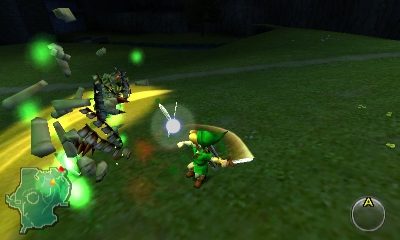
Remember the first time you ever saw the Deku Tree? Remember how immersive Hyrule felt, with 64-bit graphics so realistic and detailed that you imagined you were actually inside Dodongo’s Cavern? Remember how pissed off you got with the Water Temple, how you couldn’t find that one last Small Key you needed to retrieve the Boss Key? It’s time to journey backwards a decade and a half to rediscover everything that The Legend of Zelda: Ocarina of Time held, and to experience the game in sleek, polished 3D.
Platform: 3DS
Publisher: Nintendo
Developer: Grezzo
Genre: It’s a Zelda Game. Come On.
Release Date: June 19, 2011
ESRB Rating: Everyone
On the Warp Zoned Podcast, we’ve recently touched on game reboots and remakes. Where reboots are generally hit or miss, game remakes are often met with an apathetic welcome, fading off into the distance shortly after their presentation. Very few games ever garner enough of a reputation to warrant a remake, and of those, very few succeed in their rebirth. The Legend of Zelda: Ocarina of Time 3D is one of those few successful remakes: it’s considered one of the best games of all time and has achieved legendary status. The only thing Ocarina needed was a more modern twist, inviting all gamers – young and old – to play. The invitation has been sent, and oh, what a party it was!
The first thing that instantly stands out about Ocarina 3D is the consistency of the game from the original; it feels and plays exactly the same as the N64 classic. At this point, it’s clear that Ocarina 3D is a polished port of the game, and not a remake from the ground up. All the music and sounds are the same sound files used in the original and every environment is a shinier mirror image from the N64 version.
The new, defined textures are the most noticeable change in Ocarina 3D, aside from the 3D visual effect itself. The game’s characters are the ones who best show off the new high-resolution upgrade. Princess Zelda no longer has a watermelon for a torso, and finally isn’t made up of colored building blocks. The environments look great, the enemies are more intimidating, and the landscapes finally have some definition. The only other way to break out of the N64 era would be to knock down the walls surrounding every area of the game.
It would be redundant to discuss the gameplay, since it hasn’t changed from the original. Needless to say, the game features the same tried-and-true action RPG scenarios that the Zelda series has used for the last 25 years. The 3DS controls are intuitive though, and much better than expected from a handheld device. The device’s analog nub, though gripless, is a welcome alternative to the N64’s now-shoddy joystick. My biggest concern with the initial idea of this game involved the utilization of the game’s items. Remember how the player could have buttons for three items, a sword, a shield, first-person view, and a target-lock system?

In this version, the developers made the right move by rethinking the possibilities, adding two additional item-oriented touch buttons (labeled I and II) on the 3DS’ touch screen. The player is now able to hold an extra item in place of the original game’s first-person view button. First-person view and the Navi communication are also designated to their own touch-screen buttons. The thought of all these extra touch-screen buttons in addition to the six main buttons on the 3DS might be a bit daunting, but it works very smoothly, and I’ve personally come to prefer this setup to the N64 controller. Really, you have to try it to believe it.
The last feature I really enjoyed was the game’s use of the 3DS’ built-in gyroscope. Normally, I hate tacked-on features like unnecessary Wiimote controls – I’m looking at you, Twilight Princess! – but in this case, I was willing to make an exception. Aiming my slingshot/bow by moving my 3DS around was actually pretty cool though, as if there was a Skulltula on the wall next to me – egh, there is. Gross. Hang on… okay. The gyroscope made the first-person view feel a bit more “unhinged,” and felt like the closest Zelda will ever come to being an AR game. The initial interest in the 3D and gyroscope features definitely wears off a bit; I ended up using the joystick to aim while playing in 2D after finishing roughly half the game.
All in all, everything is where it should be. Everything that made the original Ocarina of Time such a great title is still intact, and everything it needed to become an even better title is now added. Unlike the case of most remakes, Ocarina 3D doesn’t detract from the original game, but re-imagines it, and does it well. Fans of most any Zelda game will recognize this game as an instant classic, and fans of the original Ocarina of Time will regard this remake as a success, maybe even one for the books.
The only thing left to ask is: “Why did Princess Zelda take down the pictures of the Nintendo characters in the castle?”

Review Disclosure: A retail copy of The Legend of Zelda: Ocarina Of Time 3D was purchased by Warp Zoned for the purposes of this review.







